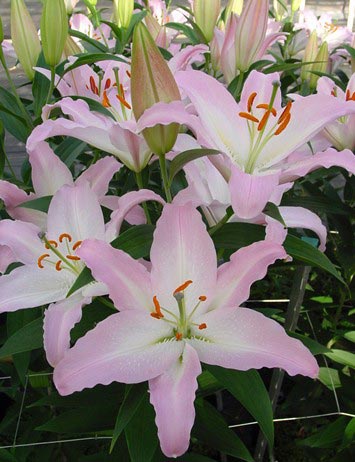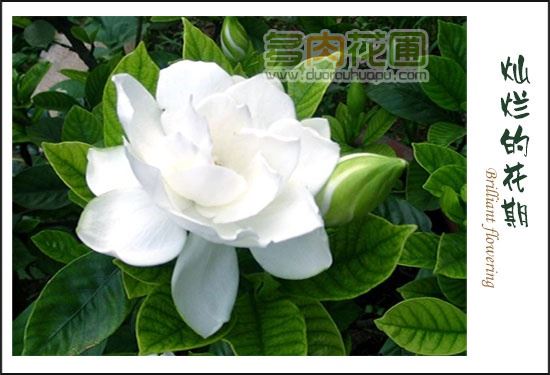Culture methods of lilies
The suitable temperature for the growth of lily is 1525 ℃, the temperature is lower than 10 ℃, the growth is slow, and when the temperature is more than 30 ℃, the growth is poor. In the process of growth, the temperature of 21: 23 ℃ in daytime and 15: 17 ℃ at night was the best. The bulbs that promote cultivation must be stored at 7: 10 ℃ for 4 to 6 weeks. This growth habit of lilies determines its maintenance mode.
First, to choose a full, robust kind of bulb. The bulb circumference of Asian series must be 10-12 cm, and that of oriental series must be 12-14 cm. The larger the bulb, the more buds.
Second, soil preparation and fertilization should be paid attention to, lilies have strong adaptability, and the climate is mild and sunny. The soil should be sandy loam with deep soil layer and good drainage, followed by clay, and waterlogged land should not be planted.
Third, proper pruning and planting are beneficial to the growth of lilies. The lily can be propagated by sowing method, scale cutting method, seed ball breeding method and so on.
Fourth, it should be drained when appropriate. Lilies need wet water to grow, which is beneficial to the growth of stems and leaves. If the soil is too wet, stagnant water or poor drainage, the lily bulbs will rot and die. Watering of potted lilies should be gradually increased with the growth of plants, sufficient water supply should be provided during flowering, water should be reduced after flowering, and watering should be stopped after aboveground parts withered. The basin soil is too wet, which also causes the bulb to rot.
Fifth, it needs enough light. Lily likes to shine with soft light. Also resistant to strong light and semi-shade, lack of light will cause buds to fall off and reduce the number of flowers. There is plenty of light, the plants are strong and short, and the flowers are bright.
6. diseases that may be encountered in lilies and their control.
Lily diseases and insect pests are mainly caused by black spot, gray mold and rust, which can be controlled by spraying 500 times of 25% carbendazim wettable powder. Insect pests are harmful to grubs and aphids and can be sprayed with 1000 times of dichlorvos EC.
Culture methods of lilies
The suitable temperature for the growth of lily is 1525 ℃, the temperature is lower than 10 ℃, the growth is slow, and when the temperature is more than 30 ℃, the growth is poor. In the process of growth, the temperature of 21: 23 ℃ in daytime and 15: 17 ℃ at night was the best. The bulbs that promote cultivation must be stored at 7: 10 ℃ for 4 to 6 weeks. This growth habit of lilies determines its maintenance mode. First, the choice of lily seedlings: to choose a full, robust bulb. The bulb circumference of Asian series must be 10-12 cm, and that of oriental series must be 12-14 cm. The larger the bulb, the more buds. Second, soil preparation and fertilization should be paid attention to, lilies have strong adaptability, and the climate is mild and sunny. The soil should be sandy loam with deep soil layer and good drainage, followed by clay, and waterlogged land should not be planted. Third, proper pruning and planting are beneficial to the growth of lilies. Breeding lilies can be cultivated by sowing method, scale cutting method, seed ball culture method and so on. Fourth, it should be drained when appropriate. Lilies need wet water to grow, which is beneficial to the growth of stems and leaves. If the soil is too wet, stagnant water or poor drainage, the lily bulbs will rot and die. Watering of potted lilies should be gradually increased with the growth of plants, sufficient water supply should be provided during flowering, water should be reduced after flowering, and watering should be stopped after aboveground parts withered. The basin soil is too wet, which also causes the bulb to rot. Fifth, the cultivation of lilies needs enough light. Lily likes to shine with soft light. Also resistant to strong light and semi-shade, lack of light will cause buds to fall off and reduce the number of flowers. There is plenty of light, the plants are strong and short, and the flowers are bright. 6. Disease and pest control of lilies. Lily diseases and insect pests are mainly caused by black spot, gray mold and rust, which can be controlled by spraying 500 times of 25% carbendazim wettable powder. Insect pests are harmful to grubs and aphids and can be sprayed with 1000 times of dichlorvos EC.
Culture methods of lilies | pictures of lilies

The suitable temperature for the growth of lily is 1525 ℃, the temperature is lower than 10 ℃, the growth is slow, and when the temperature is more than 30 ℃, the growth is poor. In the process of growth, the temperature of 21: 23 ℃ in daytime and 15: 17 ℃ at night was the best. The bulbs that promote cultivation must be stored at 7: 10 ℃ for 4 to 6 weeks. This growth habit of lilies determines its maintenance mode. First, the choice of lily seedlings: to choose a full, robust bulb. The bulb circumference of Asian series must be 10-12 cm, and that of oriental series must be 12-14 cm. The larger the bulb, the more buds. Second, soil preparation and fertilization should be paid attention to, lilies have strong adaptability, and the climate is mild and sunny. The soil should be sandy loam with deep soil layer and good drainage, followed by clay, and waterlogged land should not be planted. Third, proper pruning and planting are beneficial to the growth of lilies. Breeding lilies can be cultivated by sowing method, scale cutting method, seed ball culture method and so on. Fourth, it should be drained when appropriate. Lilies need wet water to grow, which is beneficial to the growth of stems and leaves. If the soil is too wet, stagnant water or poor drainage, the lily bulbs will rot and die. Watering of potted lilies should be gradually increased with the growth of plants, sufficient water supply should be provided during flowering, water should be reduced after flowering, and watering should be stopped after aboveground parts withered. The basin soil is too wet, which also causes the bulb to rot. Fifth, the cultivation of lilies needs enough light. Lily likes to shine with soft light. Also resistant to strong light and semi-shade, lack of light will cause buds to fall off and reduce the number of flowers. There is plenty of light, the plants are strong and short, and the flowers are bright. 6. Disease and pest control of lilies. Lily diseases and insect pests are mainly caused by black spot, gray mold and rust, which can be controlled by spraying 500 times of 25% carbendazim wettable powder. Insect pests are harmful to grubs and aphids and can be sprayed with 1000 times of dichlorvos EC.
- Prev

Culture methods of lilies
The suitable temperature for the growth of lily is 1525 ℃, the temperature is lower than 10 ℃, the growth is slow, and when the temperature is more than 30 ℃, the growth is poor. In the process of growth, the temperature of 21: 23 ℃ in daytime and 15: 17 ℃ at night was the best. Bulbs that facilitate cultivation must be stored at 7: 10 ℃ for 4 to 6 weeks.
- Next

Culture method of Gardenia jasminoides
Gardenia is not only a good helper to improve the home environment, but also an expert in improving the air quality of the community, so how can we maintain it to make it grow better? First, do a good job in breeding. We know that the reproduction of gardenia can be divided into sexual reproduction and asexual reproduction.
Related
- Fuxing push coffee new agricultural production and marketing class: lack of small-scale processing plants
- Jujube rice field leisure farm deep ploughing Yilan for five years to create a space for organic food and play
- Nongyu Farm-A trial of organic papaya for brave women with advanced technology
- Four points for attention in the prevention and control of diseases and insect pests of edible fungi
- How to add nutrient solution to Edible Fungi
- Is there any good way to control edible fungus mites?
- Open Inoculation Technology of Edible Fungi
- Is there any clever way to use fertilizer for edible fungus in winter?
- What agents are used to kill the pathogens of edible fungi in the mushroom shed?
- Rapid drying of Edible Fungi

